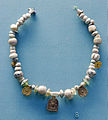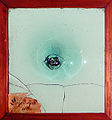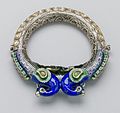History of glass
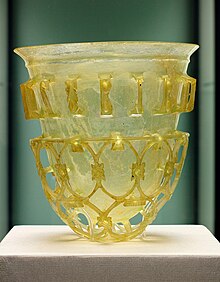
The history of glass-making dates back to at least 3,600 years ago in Mesopotamia. However, most writers claim that they may have been producing copies of glass objects from Egypt.[1] Other archaeological evidence suggests that the first true glass was made in coastal north Syria, Mesopotamia or Egypt.[2] The earliest known glass objects, of the mid 2,000 BCE, were beads, perhaps initially created as the accidental by-products of metal-working (slags) or during the production of faience, a pre-glass vitreous material made by a process similar to glazing.[n 1] Glass products remained a luxury until the disasters that overtook the late Bronze Age civilizations seemingly brought glass-making to a halt.
Development of glass technology in India may have begun in 1,730 BCE.[3]
From across the former
Origins

Naturally occurring glass, especially the volcanic glass obsidian, has been used by many Stone Age societies across the globe for the production of sharp cutting tools and, due to its limited source areas, was extensively traded. But in general, archaeological evidence suggests that the first true glass was made in coastal north Syria, Mesopotamia or ancient Egypt.[2] Because of Egypt's favorable environment for preservation, the majority of well-studied early glass is found there, although some of this is likely to have been imported. The earliest known glass objects, of the mid-third millennium BCE, were beads, perhaps initially created as accidental by-products of metal-working (slags) or during the production of faience, a pre-glass vitreous material made by a process similar to glazing.[n 1]
During the
Threads of thin glass of different colors made with admixtures of oxides were subsequently wound around these to create patterns, which could be drawn into festoons by using metal raking tools. The vessel would then be rolled smooth (marvered) on a slab in order to press the decorative threads into its body. Handles and feet were applied separately. The rod was subsequently allowed to cool as the glass slowly annealed and was eventually removed from the center of the vessel, after which the core material was scraped out. Glass shapes for inlays were also often created in moulds. Much of early glass production, however, relied on grinding techniques borrowed from stone working. This meant that the glass was ground and carved in a cold state.[6]
By the 15th century BCE, extensive glass production was occurring in
It is thought that the techniques and recipes required for the initial fusing of glass from raw materials were a closely guarded ]
Glass remained a luxury material, and the
The first glassmaking "manual" dates back to ca. 650 BCE. Instructions on how to make glass are contained in cuneiform tablets discovered in the library of the Assyrian king Ashurbanipal.[citation needed]
In Egypt, glass-making did not revive until it was reintroduced in
During the
According to
"The tradition is that a merchant ship laden with
nitrum being moored at this place, the merchants were preparing their meal on the beach, and not having stones to prop up their pots, they used lumps of nitrum from the ship, which fused and mixed with the sands of the shore, and there flowed streams of a new translucent liquid, and thus was the origin of glass."[14]
This account is more a reflection of Roman experience of glass production, however, as white silica sand from this area was used in the production of glass within the Roman Empire due to its high purity levels. During the 1st century BCE,
History by culture
Iran
The first Persian glass comes in the form of beads dating to the late Bronze Age (1600 BCE), and was discovered during the explorations of Dinkhah Tepe in
Glass tubes containing
India
Evidence of glass during the
Texts such as the
The site of Kopia, in Uttar Pradesh, is the first site in India to locally manufacture glass, with items dating between the 7th century BCE to the 2nd century CE.[21] Early Indian glass of this period was likely made locally, as they differ significantly in chemical composition when compared to Babylonian, Roman and Chinese glass.[20]
By the 1st century AD, glass was being used for ornaments and casing in South Asia.
China
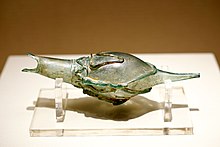
In China, glass played a peripheral role in arts and crafts when compared to ceramics and metal work.[23] The earliest glass items in China come from the Warring States period (475–221 BCE), although they are rare in number and limited in archaeological distribution.
Glassmaking developed later in China compared to cultures in Mesopotamia, Egypt and India.
During the
Romans
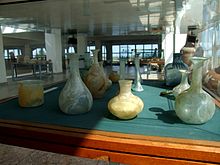
Roman glass production developed from
was used primarily for the production of vessels, although mosaic tiles and window glass were also produced.However, during the 1st century AD, the industry underwent rapid technical growth that saw the introduction of glass-blowing and the dominance of colorless or ‘aqua’ glasses. Raw glass was produced in geographically separate locations to the working of glass into finished vessels,[32][33] and, by the end of the 1st century CE, large scale manufacturing, primarily in Alexandria,[34] resulted in the establishment of glass as a commonly available material in the Roman world.
Islamic world
Islamic glass continued the achievements of pre-Islamic cultures, especially the
Africa
During
Medieval Europe

After the collapse of the Western Roman Empire, independent glass making technologies emerged in Northern Europe, with artisan
Glass objects from the 7th and 8th centuries have been found on the island of Torcello near Venice. These form an important link between Roman times and the later importance of that city in the production of the material. Around 1000 AD, an important technical breakthrough was made in Northern Europe when soda glass, produced from white pebbles and burnt vegetation was replaced by glass made from a much more readily available material: potash obtained from wood ashes. From this point on, northern glass differed significantly from that made in the Mediterranean area, where soda remained in common use.[38]
Until the 12th century,
Anglo-Saxon world
Anglo-Saxon glass has been found across England during archaeological excavations of both settlement and cemetery sites. Glass in the Anglo-Saxon period was used in the manufacture of a range of objects including vessels, beads, windows and was even used in jewelry.[39] In the 5th century AD with the Roman departure from Britain, there were also considerable changes in the usage of glass.[40] Excavation of Romano-British sites has revealed plentiful amounts of glass but, in contrast, the amount recovered from the 5th century and later Anglo-Saxon sites is minuscule.[40]
The majority of complete vessels and assemblages of beads come from the excavations of early Anglo-Saxon cemeteries, but a change in burial rites in the late 7th century affected the recovery of glass, as Christian Anglo-Saxons were buried with fewer grave goods, and glass is rarely found. From the late 7th century onwards, window glass is found more frequently. This is directly related to the introduction of Christianity and the construction of churches and monasteries.[40][41] There are a few Anglo-Saxon ecclesiastical[42] literary sources that mention the production and use of glass, although these relate to window glass used in ecclesiastical buildings.[40][41][43] Glass was also used by the Anglo-Saxons in their jewelry, both as enamel or as cut glass insets.[44][45]
Murano
The center for luxury Italian glassmaking from the 14th century was the island of
The Venetian ability to produce this superior form of glass resulted in a trade advantage over other glass producing lands. Murano’s reputation as a center for glassmaking was born when the Venetian Republic, fearing fire might burn down the city’s mostly wood buildings, ordered glassmakers to move their foundries to Murano in 1291.[citation needed] Murano's glassmakers were soon the island’s most prominent citizens. Glassmakers were not allowed to leave the Republic. Many took a risk and set up glass furnaces in surrounding cities and as far afield as England and the Netherlands.[citation needed]
Bohemia
Modern glass production
New processes


A very important advance in glass manufacture was the technique of adding lead oxide to the molten glass; this improved the appearance of the glass and made it easier to melt using sea-coal as a furnace fuel. This technique also increased the "working period" of the glass, making it easier to manipulate. The process was first discovered by George Ravenscroft in 1674, who was the first to produce clear lead crystal glassware on an industrial scale. Ravenscroft had the cultural and financial resources necessary to revolutionise the glass trade, allowing England to overtake Venice as the centre of the glass industry in the eighteenth and nineteenth centuries. Seeking to find an alternative to Venetian cristallo, he used flint as a silica source, but his glasses tended to crizzle, developing a network of small cracks destroying its transparency. This was eventually overcome by replacing some of the potash flux with lead oxide to the melt.[48]
He was granted a protective patent in where production and refinement moved from his glasshouse on the Savoy to the seclusion of Henley-on-Thames.[49]
By 1696, after the patent expired, twenty-seven glasshouses in England were producing flint glass and were exporting all over Europe with such success that, in 1746, the British Government imposed a lucrative tax on it. Rather than drastically reduce the lead content of their glass, manufacturers responded by creating highly decorated, smaller, more delicate forms, often with hollow stems, known to collectors today as Excise glasses.[50] The British glass making industry was able to take off with the repeal of the tax in 1845.
Evidence of the use of the blown plate glass method dates back to 1620 in London and was used for mirrors and coach plates. Louis Lucas de Nehou and A. Thevart perfected the process of casting Polished plate glass in 1688 in France. Prior to this invention, mirror plates, made from blown "sheet" glass, had been limited in size. De Nehou's process of rolling molten glass poured on an iron table rendered the manufacture of very large plates possible.[51] This method of production was adopted by the English in 1773 at Ravenhead. The polishing process was industrialized around 1800 with the adoption of a steam engine to carry out the grinding and polishing of the cast glass.
Industrial production

The use of glass as a building material was heralded by
An early advance in automating glass manufacturing was patented in 1848 by the engineer Henry Bessemer. His system produced a continuous ribbon of flat glass by forming the ribbon between rollers. This was an expensive process, as the surfaces of the glass needed polishing and was later abandoned by its sponsor, Robert Lucas Chance of Chance Brothers, as unviable. Bessemer also introduced an early form of "Float Glass" in 1843, which involved pouring glass onto liquid tin.
In 1887, the mass production of glass was developed by the firm Ashley in Castleford, Yorkshire. This semi-automatic process used machines that were capable of producing 200 standardized bottles per hour, many times quicker than the traditional methods of manufacture.[53] Chance Brothers also introduced the machine rolled patterned glass method in 1888.[54]
In 1898, Pilkington invented Wired Cast glass, where the glass incorporates a strong steel-wire mesh for safety and security. This was commonly given the misnomer "Georgian Wired Glass" but it greatly post-dates the Georgian era.[55] The Machine Drawn Cylinder technique was invented in the US and was the first mechanical method for the drawing of window glass. It was manufactured under licence in the UK by Pilkington from 1910 onwards.
In 1938, the
Gallery
-
Glass ear stud, c. 1390–1353 BC, 48.66.30, Brooklyn Museum
-
Phoenician glass necklace 5th–6th century BC
-
Roman glass amphoriskoi 1st–2nd century AD
-
Blue head flask (Roman, AD 300–500, cast glass)
-
Lombardic glass drinking horn 6th–7th century AD
-
Mouth-blown window-glass in Sweden Kosta Glasbruk, (1742) with a pontil mark from the glassblower's pipe
-
Two cups cobalt blue glass with gilt floral decoration from India, Mughal, circa 1700–1775
-
Base for a water pipe, India, Mughal, c. 1700–1775
-
Venetian goblet made in Italy in the early 19th century
-
Bracelets with peacocks, Delhi, enameled silver inlaid with gemstones and glass, 19th century
-
Jug, 1876, James Powell & Sons
-
Siphon bottle for seltzer water, 1922
-
New Martinsville Glass Hostmaster Tea Cup, cobalt blue, 1930
-
Perfume set from Soviet Union, c. 1965
See also
Notes
- ^ a b True glazing over a ceramic body was not used until many centuries after the production of the first glass.
- ^ Found on the MY Oi 701, MY Oi 702, MY Oi 703 and MY Oi 704 tablets; the least damaged, as far as this word is concerned, is MY Oi 703.[10]
- ^ Cf. κύανος.[11]
- ^ This process was used extensively until early in the 20th Century to make window glass.
References
- ^ "Glass making may have begun in Egypt, not Mesopotamia Artifacts from Iraq site show less sophisticated technique, color palette". 2016-11-22. Retrieved 2016-11-25.
- ^ a b "Glass Online: The History of Glass". Archived from the original on April 15, 2011. Retrieved 2007-10-29.
- ^ ISBN 0-415-18429-0.
- OCLC 28413934.
- S2CID 163645343.
- ^ Wilde, H. "Technologische Innovationen im 2. Jahrtausend v. Chr. Zur Verwendung und Verbreitung neuer Werkstoffe im ostmediterranen Raum". GOF IV, Bd 44, Wiesbaden 2003, 25–26.
- ^ "The Linear B word ku-wa-no-wo-ko". Palaeolexicon. Word study tool for ancient languages.
- ISBN 3-447-04781-X
- ISBN 1-57498-041-6
- ^ "MY Oi 701 (63)". "MY Oi 702 (64)". "MY Oi 703 (64)". "MY Oi 704 (64)". "Database of Mycenaean at Oslo DĀMOS: publisher: University of Oslo".
- Perseus Project.
- ^ a b "Kielich (flet) z herbami "Pogoń" i "Szreniawa"". muzea.malopolska.pl (in Polish). Retrieved 7 July 2014.
- ISBN 0-85429-117-2.
- Agricola, Georgius, De re metallica, translated by Herbert Clark Hoover and Lou Henry Hoover, Dover Publishing. De Re Metallica Trans. by Hoover Online Version Page 586. Retrieved September 12, 2007
- ^ "Israel Antiquities Authority".
- ^ "Kiln Site in Israel May Have Produced "Judean Glass" - Archaeology Magazine".
- OCLC 933388489.
- ^ ISBN 90-04-09262-5.
- ^ "The Ancient Indus Valley" (PDF).
- ^ ISBN 8173716196.
- ^ Kanungo, Alok K.; Brill, Robert H. (January 2009). "Kopia, India's First Glassmaking Site: Dating and Chemical Analysis". Journal of Glass Studies. 51: 11–25.
- ISBN 90-04-09262-5.
- ISBN 8822251628.
- ^ a b Pinder-Wilson, R. (1991) "The Islamic lands and China" p. 140 in Tait, H. (ed) Five thousand years of glass. University of Pennsylvania Press.
- ISBN 8822251628
- ISBN 0521838339
- ISBN 8822251628.
- ^ Jenyns, R. (1981) Chinese Art III: Textiles, Glass and Painting on Glass. Phaidon Press
- ISBN 9780872901551.
- ^ The Art Journal. Virtue and Company. 1888.
- ^ The Glass Industry. Ashlee Publishing Company. 1920.
- ^ Fleming, S. J., 1999. Roman Glass; reflections on cultural change. Philadelphia, University of Pennsylvania Museum of Archaeology and Anthropology.
- S2CID 193096925.
- ISBN 0-7456-4310-8. p. 19
- , History of Science and Technology in Islam.
- ^ Hassan, Ahmad Y. The Manufacture of Coloured Glass Archived 2010-11-16 at the Wayback Machine, History of Science and Technology in Islam.
- ISBN 0-521-20598-0.
- ^ Donny L. Hamilton. "Glass Conservation". Conservation Research Laboratory, Texas A&M University. Retrieved 2007-03-21.
- ISBN 0861591275
- ^ ISBN 0861591275
- ^ a b Heyworth, M. (1992) "Evidence for early medieval glass-working in north-western Europe" pp. 169–174 in S. Jennings and A. Vince (eds) Medieval Europe 1992: Volume 3 Technology and Innovation. York: Medieval Europe 1992
- ^ Ecclesiastical: Of or relating to a church or to an established religion.
- .
- ISBN 0861591275
- ^ Bimson, M. (1978) "Coloured glass and millefiori in the Sutton Hoo Ship Burial". In Annales du 7e congrès international d'etude historique du verre: Berlin, Leipzig, 15–21 August 1977: Liège: Editions du Secretariat Général.
- Georg Agricola De Natura Fossilium, Textbook of Mineralogy, M.C. Bandy, J. Bandy, Mineralogical Society of America, 1955, p. 111 Section on Murano Glass, De Natura Fossilium. Retrieved 2007-09-12.
- )
- ISBN 0-408-10623-9.
- S2CID 112031479.
- ISBN 0-00-211379-1.
- ^ Encyclopædia Britannica 11th edition (1911)
- ISBN 0900682604
- ISBN 9780399115233.
- ^ "Chance Brothers and Co". Retrieved 2012-12-17.
- ISBN 9780754645573.
- S2CID 109981215.
- ^ "Borosilikatglas BOROFLOAT®". SCHOTT AG.
- ^ Bickerstaff, Kenneth and Pilkington, Lionel A B U.S. patent 2,911,759 "Manufacture of flat glass". Priority date December 10, 1953
Further reading
- Carboni, Stefano; Whitehouse, David (2001). Glass of the sultans. New York: The Metropolitan Museum of Art. ISBN 0870999869.


